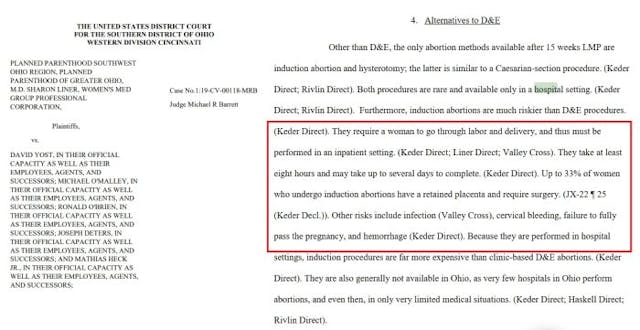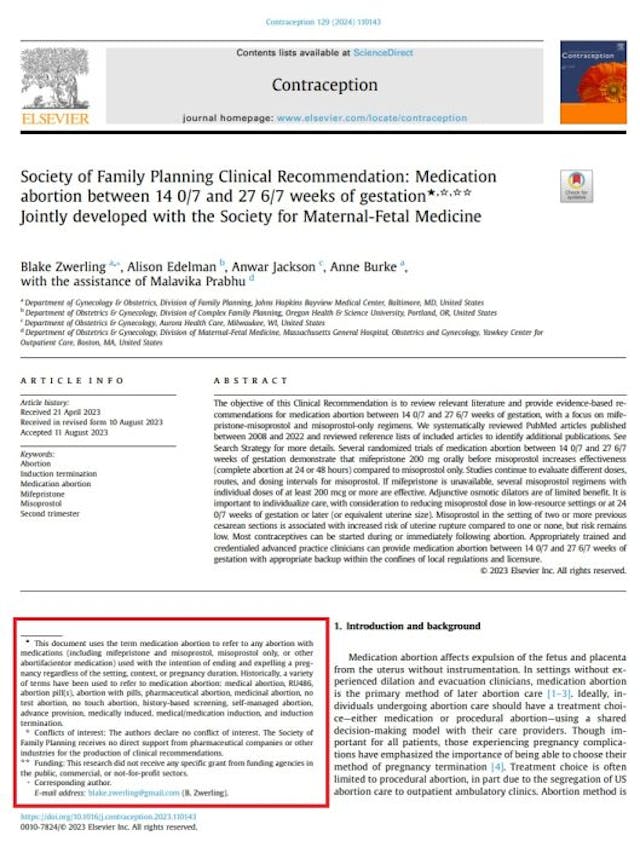
Texas library can keep sexually explicit material from minors... for now
Sheena Rodriguez
·
Abortion Pill·By Carole Novielli
Pro-abortion group recommends using abortion pill for third-trimester abortions
Despite common claims that later abortions are a work of fiction, “clinical recommendations” published by a pro-abortion group are encouraging the use of the abortion pill for third-trimester abortions up to nearly 28 weeks gestation. These recommendations follow other studies which suggest the drug regimen was being tested well into the second trimester of pregnancy.
Live Action News has previously covered horrific incidents of the abortion pill ending the lives of babies well into the 30th week of pregnancy.
“Treatment Choice”?
The authors of the “Society of Family Planning Clinical Recommendation: Medication abortion between 14 0/7 and 27 6/7 weeks of gestation” allegedly reviewed “PubMed articles published between 2008 and 2022” — and the authors suggest that abortion clients should have “treatment choice” between procedural (surgical) or chemical (mifepristone) abortions, even very late in pregnancy. The “Clinical Recommendation” claimed to review “relevant literature” which they said provided “evidence-based recommendations for medication abortion between 14 0/7 and 27 6/7 weeks of gestation.”
“This document uses the term medication abortion to refer to any abortion with medications (including mifepristone and misoprostol, misoprostol only, or other abortifacient or medication) used with the intention of ending and expelling a pregnancy regardless of the setting, context, or pregnancy duration,” the report — jointly developed with the Society for Maternal-Fetal Medicine — stated.
“Medication abortion affects expulsion of the fetus and placenta from the uterus without instrumentation. In settings without experienced dilation and evacuation clinicians, medication abortion is the primary method of later abortion care,” the authors wrote.
They suggested using “mifepristone 200 mg (where available) plus misoprostol 200 mcg vaginally or buccally every 3 hours for medication abortion between 24 0/7 and 27 6/7 weeks of gestation (GRADE 2C),” the authors wrote. “If mifepristone is unavailable, we suggest misoprostol 200 mcg vaginally or buccally every 3 hours for medication abortion between 24 0/7 and 27 6/7 weeks of gestation (GRADE 2C).”
Oddly, they also claimed that “no universally accepted definition of successful abortion exists,” adding:
Some studies define success as complete abortion without the need for procedural intervention.
Other studies define success as fetal and placental expulsion within a prespecified time frame, usually 24 or 48 hours.
For the purpose of this guideline, a successful abortion is defined as expulsion of the entire pregnancy by the medical method intended without additional intervention.
But the authors also wrote that “no accepted definition of failure exists,” claiming:
Many studies arbitrarily set a specific time frame, usually 24 or 48 hours or if a procedural intervention is necessary to remove the fetus, placenta, or both.
Time frames do not correspond to increased risk of complications, nor do they indicate that success will not eventually occur.
For the purpose of this guideline, a failed abortion is the counterpart to our defined successful abortion.
Potential Dangers
The abortion pill was approved by the Food and Drug Administration (FDA) in 2000. In 2016, the FDA extended use of the approved drug regimen of mifepristone (mifeprex) and misoprostol through 10 weeks/70 days gestation. Despite the fact that the FDA is monitoring this drug under their REMS safety system, prescribers are openly selling the drugs to women well past these gestational limits.
Recommendations implied abortion pill use in the third trimester should be committed in a hospital or facility:
Medication abortion between 14 0/7 and 27 6/7 weeks of gestation continues to primarily be a facility-based process (ambulatory and hospital based). This standard is based on current practice patterns and not evidence. A facility-based process enables access to a wide range of pain control options and expedient management of common problems associated with medication abortion at 14 0/7 to 27 6/7 weeks of gestation, such as retained placenta.
Facility-based care may also provide access to related resources, such as spiritual care, bereavement services, and fetal remains disposition. However, facility-based care is costly, is less private, and may not be necessary for all patients. Patients do not need to be directly observed for the entire process.
Mifepristone can be ingested prior to facility presentation. Initial doses of misoprostol can also be started for patients at low risk for extramural delivery. Since abortion in some instances can occur within a few hours of first misoprostol dose, and cramping and bleeding may also occur shortly after misoprostol dosing, the decision to do this should be taken carefully.
Article continues below
Dear Reader,
Have you ever wanted to share the miracle of human development with little ones? Live Action is proud to present the "Baby Olivia" board book, which presents the content of Live Action's "Baby Olivia" fetal development video in a fun, new format. It's perfect for helping little minds understand the complex and beautiful process of human development in the womb.
Receive our brand new Baby Olivia board book when you give a one-time gift of $30 or more (or begin a new monthly gift of $15 or more).
Appropriately trained and credentialed clinicians can provide medication abortion after 13 6/7 weeks of gestation with appropriate backup, especially as the care is similar to obstetric delivery care that is routinely provided by advanced practice clinicians.
“Existing studies demonstrate a 2% to 20% hemorrhage incidence related to medication abortion, but blood transfusion is rare,” the authors claimed, adding that “Retained placenta is the most common complication that can occur with medication abortion between 14 0/7 and 27 6/7 weeks of gestation (12%–33%) and can be treated safely with aspiration without subsequent hemorrhage or need for transfusion.”
But medical malpractice attorney Michael Seibel told Live Action News, “It is well established that each week after 18 weeks carries a risk of death which is greater than delivery of the baby.” He added:
Leaving a patient to self monitor symptoms and potential health risks at this stage it is foreseeable that the patient could suffer serious injury or death. In fact Keisha Atkins was only 24 weeks pregnant and doctors could not adequately monitor her health at an outpatient clinic which ultimately lead to her death.
Seibel pointed out that these are essentially third trimester inductions using abortion drugs. Seibel claimed that multiple abortion providers — including abortion experts like Mark Nichols and Lisa Keder — have testified that inductions should be committed in a hospital.

Live Birth Risk from Late Term Abortion Pills
The authors wrote, “Medication abortion has a lower completion rate than procedural abortion,” adding that “medication abortion at 14 0/7 to 27 6/7 weeks of gestation may offer patients a chance to hold the fetus, an intact fetus for autopsy or genetic diagnosis, and a potential option to avoid a procedure….”
“Inducing fetal asystole [use of potassium chloride (KCl), digoxin, or lidocaine to stop the baby’s heart] before medication abortion at near-viable gestational durations to avoid signs of life at time of expulsion is practiced widely for legal considerations as well as patient and provider comfort,” they noted.
Attorney Mike Seibel pointed out that if a woman were to deliver her baby alive and medical providers failed to render care to the child, the providers could potentially face homicide charges.
“As a whole separate issue, use at this late stage could lead to charges for a mother and or prescriber to criminal homicide and/or abuse neglect for willfully or recklessly failing to provide medical care for a fully formed infant who survives the medication abortion past the age of viability,” claimed Seibel.
Women who take abortion pills at home could potentially see the remains of their babies once expelled into a toilet. In the third trimester, an aborted child would be far too large to flush.
Conflicts and Funding from Abortion Pill Investors
The authors declared “no conflict of interest” and the clinical recommendation published in the Journal Contraception claimed that “The Society of Family Planning receives no direct support from pharmaceutical companies or other industries for the production of clinical recommendations.”
But the Society of Family Planning (SFP) itself was founded in 2005 with a “generous contribution” from the Packard Foundation. SFP is heavily funded by the pro-abortion Buffett Foundation, receiving $10M in 2023 alone. Both Packard and Buffett were investors of the manufacturers of the abortion pill, namely either Danco Laboratories or the generic GenBioPro.

Journal Contraception is the official journal of SFP, and its editorial board is stacked with abortion industry insiders, including Alice Mark (a National Abortion Federation medical advisor and Planned Parenthood clinician), abortionists like Daniel Grossman (who unethically suggested that ER staff lie about abortion pill complications), and others like Mitchell Creinin and Courtney A. Schreiber (who have disclosed financial contributions from Danco or GenBioPro).
The Journal’s current editor is abortionist Dr. Carolyn Westhoff, former director at the Association of Reproductive Health Professionals. Westhoff was involved in original abortion pill clinical trials and previously testified in favor of keeping partial-birth abortion legal. According to SFP, Westhoff served on board of the Guttmacher Institute and Planned Parenthood. Westhoff is a Planned Parenthood medical advisor who was seen on undercover Center for Medical Progress recordings discussing how the aborted baby body parts (including “gonads”) she provides for research are “fresh.”
Author Blake Zwerling is listed as being part of the “Division of Family Planning, Johns Hopkins Bayview Medical Center,” but an online provider directory reveals someone with the same name working at Planned Parenthood Mar Monte. A LinkedIn profile under that name states Zwerling is “attending OB/GYN physician at University of California, Davis specializing in Complex Family Planning.” The UC system is heavily funded by Buffett.
Alison Edelman, described as an OBGYN with the “Division of Complex Family Planning, Oregon Health & Science University” recently stated “I’m an OBGYN but also I’m trained in complex family planning, which is basically abortion and contraception.” Edelman added, “We need [to do] everything that we can do to allow people to access [abortion].”
The OHSU University not only assisted in stockpiling abortion pills for the state, but operates an abortion training program and commits abortions at the University’s hospital. OHSU’s Complex Family Planning Fellowship website states:
We expose our fellows to a variety of different practice settings, including free-standing abortion clinics, hospital based outpatient clinics and the hospital operating room. OHSU is a referral site for hospital-based abortion care for medically complex patients. Fellows are involved in administration of IV sedation in the outpatient clinics.
In addition, author Anwar Jackson openly spoke against the FDA’s REMS safety regulations, which limits the abortion pill mifepristone from being dispensed in the third trimester, when failures are likely to occur.
Live Action News is pro-life news and commentary from a pro-life perspective.
Contact editor@liveaction.org for questions, corrections, or if you are seeking permission to reprint any Live Action News content.
Guest Articles: To submit a guest article to Live Action News, email editor@liveaction.org with an attached Word document of 800-1000 words. Please also attach any photos relevant to your submission if applicable. If your submission is accepted for publication, you will be notified within three weeks. Guest articles are not compensated (see our Open License Agreement). Thank you for your interest in Live Action News!

Sheena Rodriguez
·
Abortion Pill
Bridget Sielicki
·
Abortion Pill
Carole Novielli
·
Abortion Pill
Bridget Sielicki
·
Abortion Pill
Bridget Sielicki
·
Abortion Pill
Nancy Flanders
·
Human Rights
Carole Novielli
·
Abortion Pill
Carole Novielli
·
Investigative
Carole Novielli
·
Investigative
Carole Novielli
·
Abortion Pill
Carole Novielli
·